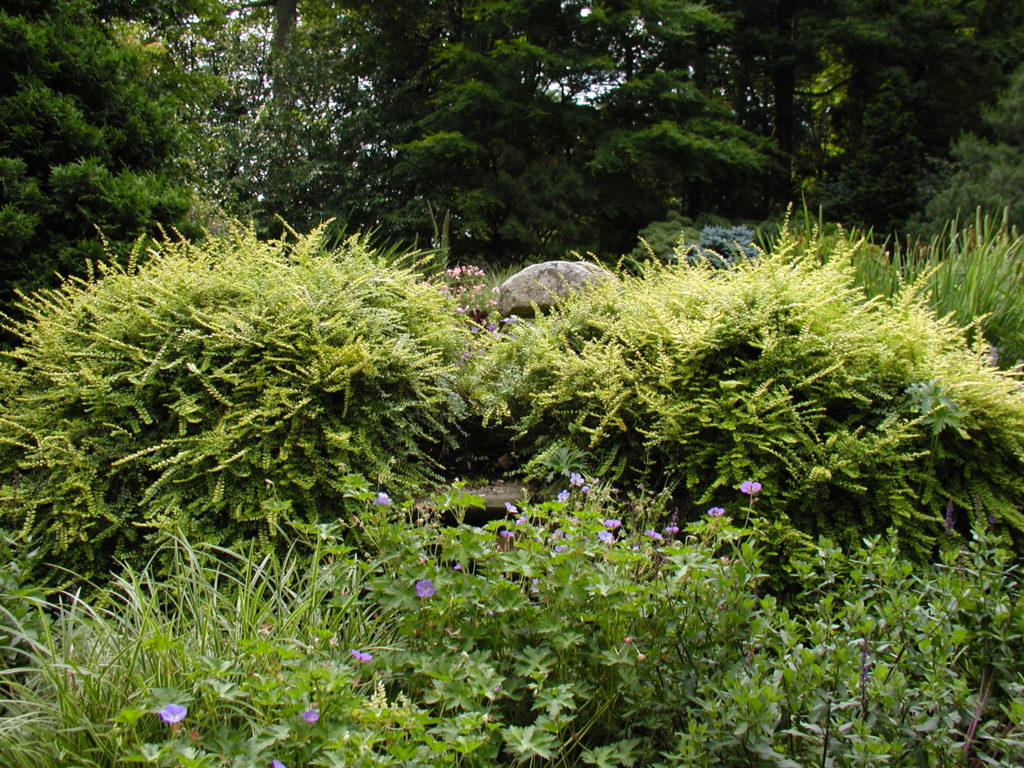Pruning is beneficial to shrubs. When properly applied, it helps shrubs develop, while retaining their natural shape and size. The following is a guide to proper shrub pruning. It examines how shrubs develop, when they can be pruned, and the best pruning techniques to apply.
Growth Habits
Understanding the growth habit of a shrub will help determine the approach one should take to pruning.
Shrubs have three types of growth habits: mounding, cane, and tree-like habits. Those that form mounding habits, such as azalea, spirea, and euonymus, are characterized by their soft, flexible stems, small leaves, and short stature. Shrubs with mounding habits are often bunched together in mass plantings. Shrubs with cane habits include forsythia, viburnums, mock oranges, and nandina. These types of shrubs have a distinct quality: they produce an abundance of branches, called canes, from their base. Examples of shrubs with tree-like habits include witch hazel, rhododendrons, rose of Sharon, sumac, and hydrangeas. These types of shrubs have thicker, woodier branches that are finely distributed amongst their base.
Types of Pruning Cuts
There are two major types of pruning cuts that can be applied to shrubs: heading cuts and thinning cuts.
Heading cuts are used to reduce shrub height and retain proper shape and form. When applied, they stimulate the buds closest to the wound. Heading cuts are most effective when applied selectively. Removing large portions of growth will encourage shrubs to produce vigorous shoots called epicormic sprouts that are fragile, and disrupt the shrub’s natural form. Heading cuts should take place a quarter of an inch above the bud, angling downwards and away. Avoid cutting too close to the bud, or slicing into it. This can cause significant tissue damage, resulting in foliar dieback. Cut away any remaining stubs. If left attached to the branch, stubs will often decay, causing the branch tissue to wither and die. When pruning above a node with multiple buds, remove those that are growing inwards.
Thinning cuts remove branches at their points of attachment. When used in moderation, thinning cuts are effective at reducing shrub density. Thinning cuts should be applied just above the parent branch, or parallel to any lateral branches.
Once a heading cut or thinning cut has been properly applied, the wound will gradually seal over. Avoid coating pruning cuts on shrubs with wound dressings made from paint compounds, tar, or other similar materials. They do not prevent decay, and can hinder wound closure.
Pruning Purposes
Pruning is generally applied to shrubs for one of two reasons: to maintain the health and shape of the shrub, or to restore an older shrub’s vitality.
Maintenance Pruning
Deciduous shrubs require pruning to maintain their health and size. Maintenance pruning should begin at the time of planting. Before extracting any live growth, always remove dead, diseased, or broken branches from the crown. When pruning dead or diseased branches, make thinning cuts into healthy wood, well below the affected area. Be sure to disinfect any pruning tools that have been used between each cut to avoid infecting other trees. On woodier shrubs, avoid damaging the branch collar. This is the part of the branch that enables the wound to seal over effectively.
To reduce the height of shrubs with a cane growth habit, remove the tallest cane, performing the cut near ground level. Proceed to thin out any canes crowding the center of the shrub. For shrubs with a mounding growth habit, only remove the longest branches, applying thinning cuts well within the center of the shrub. This will reduce the shrub by up to one third its original size without compromising its shape. When pruning shrubs with tree-like habits, begin by removing any dead, diseased, or broken branches. Then, proceed to cut out any encroaching limbs, low hanging branches, or epicormic sprouts. Next, apply selective thinning cuts to the center of the crown. This increases light penetration, and maximizes air circulation. Finally, perform heading cuts as needed to stimulate and direct new growth. When pruning tree-like shrubs, never remove more than a quarter of the shrub’s total growth.
Rejuvenation Pruning
As shrubs mature, they may exceed their natural size, establishing branches that contain large amounts of unhealthy wood. There are two rejuvenation techniques that can be used to restore older shrubs to a vigorous state. The first technique is more extensive, and involves a drastic reduction of the shrub’s height. The shrub is pruned back six to ten inches above the ground, with half of its new growth being removed. Heading cuts are then applied to some of the remaining branches to stimulate and direct their growth. Shrubs that tolerate extensive rejuvenation include: dogwood, honeysuckle, hydrangea, lilac, mallow, rose of Sharon, spirea, and abelia.
The second rejuvenation technique is more gradual, taking place over a period of three years. This approach is gentler, and will allow the shrub to replace old wood with new growth. During the first year, remove one third of the shrub’s oldest branches. For the second year, remove half of remaining older branches. Finally, in the third year, prune out any lingering older branches.
When to Prune
Shrubs should be pruned in late winter or early spring. For shrubs that bloom in spring, pruning should be delayed until just after flowering. Shrubs that bloom in summer should be pruned in early spring before buds have set, or in summer immediately after they have flowered. Shrubs can be pruned in summer to suppress foliar growth, and prevent shrubs from becoming overly vigorous. Pruning in late summer or early fall should be avoided, as it can stimulate dormant buds, encouraging them to produce new growth. In many instances, the tender growth is unable harden before the winter frost occurs, causing it to incur significant cold damage.
Image courtesy of SB Johnny


